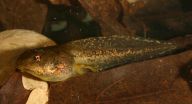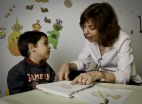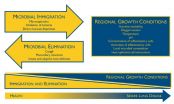(Press-News.org) We may view our memory as being essential to who we are, but new findings suggest that others consider our moral traits to be the core component of our identity. Data collected from family members of patients suffering from neurodegenerative disease showed that it was changes in moral behavior, not memory loss, that caused loved ones to say that the patient wasn't "the same person" anymore.
The findings are published in Psychological Science, a journal of the Association for Psychological Science.
"Contrary to what you might think -- and what generations of philosophers and psychologists have assumed -- memory loss itself doesn't make someone seem like a different person. Nor do most other factors, such as personality change, loss of higher-level cognition, depression, or the ability to function in daily activities," says psychological scientist Nina Strohminger of the Yale University School of Management, lead researcher on the study. "This is interesting because it shows that someone can change quite a bit and still seem like basically the same person. On the other hand, if moral faculties are compromised, a person can be rendered unrecognizable."
Strohminger and co-author Shaun Nichols of the University of Arizona had conducted previous research showing that people tend to associate moral traits with identity over other mental or physical traits. They wanted to see if this association would hold up in the context of real-world cognitive change.
The researchers recruited 248 participants with family members suffering from one of three types of neurodegenerative disease: frontotemporal dementia, Alzheimer's disease, and amyotrophic lateral sclerosis (ALS). Both frontotemporal dementia and Alzheimer's disease are associated with cognitive changes, and frontotemporal dementia is specifically associated with changes to frontal lobe function that can affect moral behavior. ALS, on the other hand, is primarily associated with loss of voluntary motor control.
The participants, mostly spouses or partners of the patients, reported the extent to which their loved one showed various symptoms typical of their disease (rating each symptom as none, mild, moderate, or severe). They also indicated the extent to which their family member had changed on 30 different traits, and how much their relationship with the patient had deteriorated since the onset of the disease.
Finally, participants reported how much they perceived the patient's identity as having changed as a result of the disease, answering questions like "Do you feel like you still know who the patient is?" and "Regardless of the severity of the illness, how much do you sense that the patient is still the same person underneath?"
The results revealed that both Alzheimer's disease and frontotemporal dementia were associated with a greater sense of identity disruption than ALS, with frontotemporal dementia leading to the greatest deterioration in identity. Importantly, the association could not be explained by differences in overall functional decline.
Statistical models showed that perceived identity change was strongly linked with change in moral traits. Almost no other symptom, including depression, amnesia, and changes in personality traits, had an observable impact on perceived identity change.
The researchers also found that the degree of perceived identity change was associated with how much the participants thought their relationship with the patient had deteriorated, and this association was driven by the degree of change in the patient's moral traits:
"Continuing to see a loved one as the same person they've always been is crucial to the health of the social bond," explains Strohminger.
Aphasia was also linked with perceived identity, albeit not as strongly as morality:
"When you think about it, it makes perfect sense: language is the most precise tool we have for conveying the content our minds to others," says Strohminger. "If someone loses this ability, it may be easy to see that person as having vanished as well."
Together, these findings suggest that moral capacities form the core of how we perceive individual identity.
Given that an estimated 36 million people are living with some form of neurodegenerative disease worldwide, these findings have direct implications for our everyday experience:
"Most of us know someone with neurodegenerative disease or some form of cognitive decline. Whether a loved one's self disappears or persists through the progression of this condition depends very much on which parts of the mind are affected," Strohminger concludes.
With these findings in mind, the researchers argue that future therapies for neurodegenerative disease must address the issue of preserving moral function, a factor that is typically overlooked, in order to ensure the well-being of patients and their families.
INFORMATION:
All data and materials have been made publicly available via Open Science Framework and can be accessed at https://osf.io/ezqft/ and https://osf.io/6rfmv/, respectively. The complete Open Practices Disclosure for this article can be found at http://pss.sagepub.com/content/by/supplemental-data. This article has received badges for Open Data and Open Materials. More information about the Open Practices badges can be found at https://osf.io/tvyxz/wiki/1.%20View%20the%20Badges/ and http://pss.sagepub.com/content/25/1/3.full.
For more information about this study, please contact: Nina Strohminger at nina.strohminger@duke.edu.
The article abstract is available online: http://pss.sagepub.com/content/early/2015/08/11/0956797615592381.abstract
The APS journal Psychological Science is the highest ranked empirical journal in psychology. For a copy of the article "Neurodegeneration and Identity" and access to other Psychological Science research findings, please contact Anna Mikulak at 202-293-9300 or amikulak@psychologicalscience.org.
WASHINGTON, August 17, 2015 -- Almost all of us have used some type of odor eliminator like Febreze to un-stink a room. These sprays can work wonders, but how do they actually work? Do they really remove the smell or just mask it? We explain the chemistry of odor elimination in this week's Reactions video. Check it out here: https://youtu.be/sNIIxzR-d_Q.
Subscribe to the series at http://bit.ly/ACSReactions, and follow us on Twitter @ACSreactions to be the first to see our latest videos.
INFORMATION:
The American Chemical Society is a nonprofit organization chartered ...
This news release is available in German.
Their results have now been published in the Nature journal Scientific Reports (doi:10.1038/srep13008) and could point the way toward improvements in hybrid solar cells.
The system they investigated is based on conventional n-type silicon wafers coated with the highly conductive polymer mixture PEDOT:PSS and displays a power conversion efficiency of about 14 %. This combination of materials is currently extensively investigated by many teams in the research community.
"We systematically surveyed the characteristic curves, ...
Millions of tons of road salt are applied to streets and highways across the United States each winter to melt ice and snow and make travel safer, but the effects of salt on wildlife are poorly understood.
A new study by biologists from Case Western Reserve University suggests exposure to road salt, as it runs off into ponds and wetlands where it can concentrate--especially during March and early April, when frogs are breeding--may increase the size of wood frogs, but also shorten their lives.
Wood frog tadpoles exposed to road salt grew larger and turned into ...
In addition to melting icecaps and imperiled wildlife, a significant concern among scientists is that higher Arctic temperatures brought about by climate change could result in the release of massive amounts of carbon locked in the region's frozen soil in the form of carbon dioxide and methane. Arctic permafrost is estimated to contain about a trillion tons of carbon, which would potentially accelerate global warming. Carbon emissions in the form of methane have been of particular concern because on a 100-year scale methane is about 25-times more potent than carbon dioxide ...
Magnetism in nanoscale layers only a few tens of atoms thick is one of the foundations of the big data revolution - for example, all the information we download from the internet is stored magnetically on hard disks in server farms dotted across the World. Recent work by a team of scientists working in Singapore, The Netherlands, USA and Ireland, published on 14 August 2015 in the prestigious journal, Science, has uncovered a new twist to the story of thin-film magnetism.
The team from the National University of Singapore (NUS) - Mr Li Changjian, a graduate student from ...
Bilingual children pose unique challenges for clinicians, and, until recently, there was little research on young bilinguals to guide clinical practice. In the past decade, however, research on bilingual development has burgeoned, and the scientific literature now supports several conclusions that should help clinicians as they assess bilingual children and advise their parents.
In an article recently published in Seminars in Speech and Language, Erika Hoff, Ph.D., a professor of psychology in the Charles E. Schmidt College of Science at Florida Atlantic University, ...
ANN ARBOR, Mich. - One of the most common complaints about hospitals is the noise. Patients complain that they can't sleep soundly in the environment of multiple monitors, paging systems, wheelchairs and gurneys, and carts that squeak.
Ongoing efforts at the University of Michigan Health System are making the hospital quieter, and the hospital has tested sound panels designed to dial down noise.
During a pilot study, strategically placed sound acoustic panels helped diffuse sound in the hallways around patient rooms. The modest 3-4 sound decibel drop is recognizable ...
When researchers dream about electronics of the future, they more or less dream of pouring liquids into a beaker, stirring them together and decanting a computer out onto the table. This field of research is known as self-assembling molecular electronics. But, getting chemical substances to self-assemble into electronic components is just as complicated as it sounds. Now, a group of researchers has published their breakthrough within the field. The group consists of first-year nanoscience students from the University of Copenhagen.
Thomas Just Sørensen, an associate ...
This news release is available in German. Two growth-promoting groups of substances, or phytohormones, the gibberellins and the brassinosteroids, are used independently of each other for the breeding and production of crop plants. A team of scientists at Technical University of Munich (TUM) has now discovered that the two act in concert - without brassinosteroids, a plant is unable to produce gibberellins.
For their current investigations, a research group at the Technical University of Munich, supported by scientists from the Helmholtz Zentrum Munich and the TU Braunschweig ...
ANN ARBOR, Mich. -- With every breath you take, microbes have a chance of making it into your lungs. But what happens when they get there? And why do dangerous lung infections like pneumonia happen in some people, but not others?
Researchers at the University of Michigan Medical School have started to answer these questions by studying the microbiome of the lungs - the community of microscopic organisms are in constant contact with our respiratory system.
By studying these bacterial communities, and how they change in illness, they hope to pave the way for new ways ...




